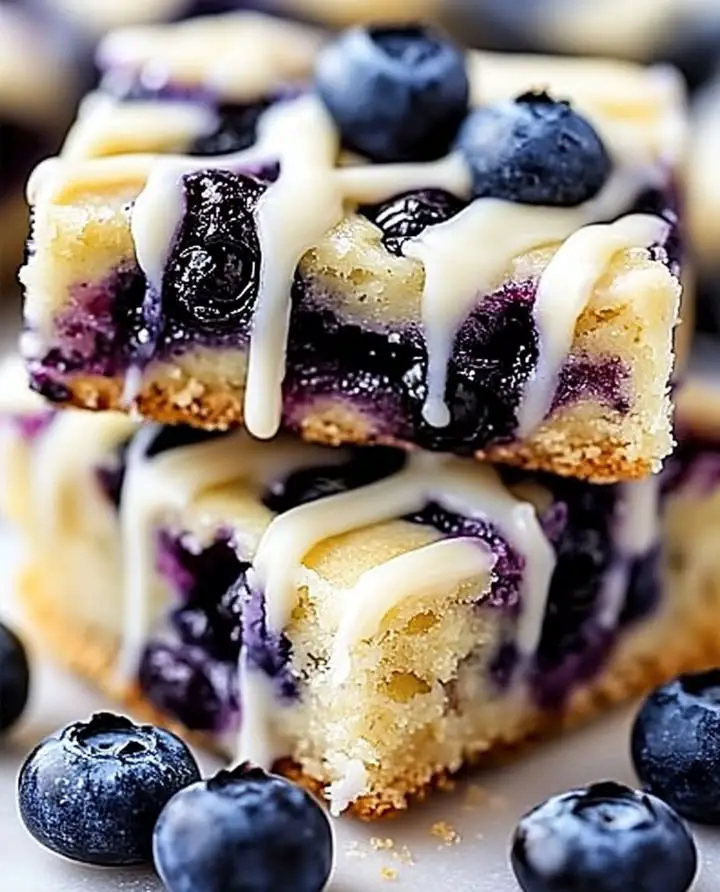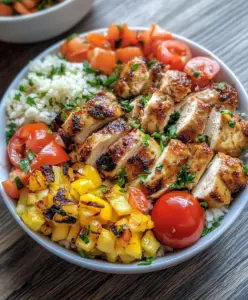Best Zesty Blueberry Lemon Cookie Bars Recipe: A Burst of Summer in Every Bite
These Best Zesty Blueberry Lemon Cookie Bars combine the bright flavors of summer with a buttery cookie crust. Imagine biting into a tender, crumbly base topped with juicy blueberries and a tangy lemon glaze. The contrast between sweet and tart creates an irresistible balance that keeps you reaching for another piece. Whether you serve them at a picnic or enjoy them with afternoon tea, these bars deliver a refreshing treat.
What makes this recipe stand out is its simplicity. You don’t need advanced baking skills to achieve bakery-quality results. The dough comes together quickly, and the filling requires minimal effort. Meanwhile, the lemon zest adds a vibrant aroma that fills your kitchen. As a bonus, these bars stay fresh for days, making them perfect for meal prep or gifting. If you love citrusy desserts with a fruity twist, this recipe will become a staple in your collection.
Quick Recipe Highlights
- Flavor Profile: The combination of sweet blueberries and zesty lemon creates a refreshing taste. A hint of vanilla in the crust adds warmth to balance the tartness.
- Texture: The cookie base stays soft yet slightly crumbly, while the blueberries burst with juiciness. The lemon glaze adds a smooth finish.
- Aroma: Fresh lemon zest and warm butter create an inviting scent. As the bars bake, the blueberry fragrance intensifies.
- Visual Appeal: Vibrant purple blueberries peek through the golden crust, topped with a glossy lemon drizzle. These bars look as good as they taste.
- Skill Level Needed: Beginner-friendly with straightforward steps. No special techniques required, just basic mixing and baking.
- Special Equipment: A 9×9-inch baking pan and parchment paper ensure easy removal. A zester or fine grater helps extract lemon zest efficiently.
Recipe Overview
- Difficulty Level: This recipe ranks as easy because it uses common ingredients and simple techniques. Even novice bakers can achieve perfect results with minimal effort.
- Category: Ideal for desserts, snacks, or brunch items. These bars work well for casual gatherings or formal events.
- Cuisine: Inspired by American dessert bars with a citrus twist. The lemon-blueberry pairing reflects modern baking trends.
- Cost: Affordable ingredients like flour, sugar, and fresh blueberries keep costs low. Lemon zest and juice add flavor without breaking the budget.
- Season: Perfect for spring and summer when blueberries are at their peak. The bright flavors also lift moods during colder months.
- Occasion: Great for potlucks, picnics, or as a homemade gift. They also make a delightful afternoon treat with coffee or tea.
Why You’ll Love This Recipe
The Best Zesty Blueberry Lemon Cookie Bars offer a perfect balance of flavors and textures. First, the buttery cookie base provides a rich foundation that complements the juicy blueberries. Next, the lemon glaze adds a tangy contrast that enhances the overall taste. Moreover, the recipe requires minimal prep time, making it ideal for busy schedules. You can whip up a batch in under an hour with ingredients you likely already have.
Beyond taste, these bars pack nutritional benefits. Blueberries deliver antioxidants and vitamins, while lemon zest adds a dose of vitamin C. Unlike overly sugary desserts, this recipe lets the natural sweetness of fruit shine. Additionally, the bars stay moist for days, so you can enjoy them fresh or as leftovers. Their portable nature makes them perfect for lunchboxes or road trips.
Entertaining becomes effortless with this crowd-pleasing dessert. Guests always appreciate homemade treats, and these bars look impressive without requiring fancy decoration. You can customize them by adding nuts or swapping berries based on preference. Furthermore, children and adults alike adore the vibrant colors and refreshing taste. Whether served at a barbecue or a bridal shower, they never disappoint.
Cost-effectiveness is another advantage. Fresh blueberries often go on sale during summer, and lemons remain affordable year-round. The recipe yields 16 generous portions, stretching your ingredients further. Compared to store-bought desserts, homemade versions save money while tasting superior. You also control the quality of ingredients, avoiding preservatives or artificial flavors.
Finally, the recipe adapts easily to dietary needs. Gluten-free flour blends work well for the crust, and dairy-free butter substitutes maintain texture. For a lower-sugar version, reduce the glaze quantity or use a natural sweetener. With so many possible tweaks, everyone can enjoy these delightful bars regardless of dietary restrictions.
Historical Background and Cultural Significance
Cookie bars trace their roots to early American baking traditions. Settlers adapted European pastry techniques to create simpler, more portable desserts. Over time, bars became popular for their convenience and versatility. The addition of fruit fillings emerged as a way to incorporate seasonal produce into sweets. Blueberries, native to North America, naturally found their way into these recipes.
Lemon-blueberry pairings gained prominence in the 20th century. As citrus fruits became more accessible, bakers experimented with bright flavor combinations. The tartness of lemon balanced the sweetness of blueberries, creating a harmonious blend. Today, this duo appears in everything from muffins to cheesecakes, reflecting its enduring appeal.
The evolution of dessert bars mirrors changing kitchen technologies. Early versions relied on wood-fired ovens, while modern recipes benefit from precise temperature control. Contemporary bakers also emphasize presentation, elevating humble bars into Instagram-worthy treats. Despite these changes, the core appeal remains: delicious, shareable desserts with minimal fuss.
Regional variations abound based on local ingredients. In Maine, wild blueberries dominate dessert bars, while Florida bakers might add extra citrus. Some versions incorporate spices like cinnamon or nutmeg for warmth. Regardless of adaptations, the essence of a good cookie bar lies in its perfect balance of textures and flavors.
Ingredient Deep Dive
Blueberries take center stage in this recipe, offering both flavor and nutrition. Native to North America, these berries have sustained indigenous communities for centuries. Packed with antioxidants, they support heart health and cognitive function. When selecting blueberries, look for plump, firm berries with a dusty blue hue. Avoid containers with moisture or crushed fruit. Store them unwashed in the refrigerator for up to a week, or freeze for longer preservation.
Fresh lemons provide the zesty kick that defines these bars. The citrus fruit originated in Asia but spread globally through trade routes. Lemon zest contains essential oils that deliver intense aroma and flavor. Always choose firm, heavy lemons with bright yellow skin. Room-temperature lemons yield more juice, while cold ones zest more easily. For substitutions, try lime or orange zest, though the flavor profile will shift slightly.
Butter forms the base of the cookie crust, contributing richness and texture. High-quality unsalted butter allows you to control the salt content. European-style butter with higher fat content creates an especially tender crust. For dairy-free versions, plant-based butter substitutes work well. Whatever you choose, ensure it stays cold before mixing to achieve the perfect crumbly texture.
All-purpose flour provides structure to the cookie base. This pantry staple has been milled for centuries, evolving with agricultural advancements. For best results, fluff the flour before measuring to avoid dense bars. Gluten-free blends can replace traditional flour if needed. Just ensure they contain xanthan gum or another binding agent to mimic gluten’s effects.
Common Mistakes to Avoid
- Overmixing the dough: This develops gluten, making the crust tough instead of tender. Mix just until ingredients combine.
- Using warm butter: It melts too quickly, resulting in greasy bars. Keep butter cold for optimal texture.
- Skimping on lemon zest: The oils in zest provide intense flavor that juice alone cannot match.
- Overbaking the bars: They continue cooking as they cool. Remove them when edges just turn golden.
- Adding frozen blueberries directly: Thaw and pat them dry first to prevent excess moisture.
- Spreading glaze too thick: A light drizzle enhances flavor without overwhelming the bars.
- Cutting bars before cooling completely: They need time to set for clean slices.
- Using outdated baking powder: Check freshness to ensure proper rise and texture.
Essential Techniques
Proper zesting makes a significant difference in flavor extraction. Use a fine grater or microplane and only remove the yellow outer layer of the lemon. The white pith beneath tastes bitter. Rotate the lemon as you zest to maximize yield. For even distribution, mix zest with sugar first to release its oils. This simple step intensifies the citrus flavor throughout the bars.
Cutting in butter requires attention to temperature. Start with cold butter cubes and work quickly. Use a pastry cutter or two forks to break the butter into flour until pea-sized crumbs form. Alternatively, pulse briefly in a food processor. The goal is to create pockets of fat that melt during baking, producing flaky layers. If the butter softens too much, chill the mixture before proceeding.
Arranging blueberries evenly ensures consistent flavor in every bite. After pressing the dough into the pan, scatter berries by hand rather than dumping them all at once. Gently press some berries slightly into the dough while leaving others on top. This technique prevents sinking during baking and creates visual appeal. For extra juiciness, reserve a handful to sprinkle on just before baking.
Pro Tips for Perfect Best Zesty Blueberry Lemon Cookie Bars
- Chill the dough for 15 minutes before baking to prevent spreading and ensure flakiness.
- Line the pan with parchment paper, leaving overhang for easy removal and clean cuts.
- Use room-temperature eggs for better emulsification in the glaze.
- Add a pinch of salt to the glaze to balance sweetness and enhance lemon flavor.
- For deeper flavor, let the zest sit with sugar for 10 minutes before mixing.
- Dust finished bars with powdered sugar for extra visual appeal if skipping the glaze.
- Bake on the middle rack to ensure even heat distribution and prevent burning.
Variations and Adaptations
For seasonal twists, try different berries based on availability. Raspberries or blackberries work beautifully in summer, while cranberries add festive flair in winter. Adjust sugar slightly depending on berry sweetness. Frozen berries can substitute when fresh aren’t available, just increase baking time by a few minutes to account for extra moisture.
Dietary modifications accommodate various needs. Gluten-free flour blends work well when measured by weight rather than volume. Coconut oil replaces butter for dairy-free versions, though the flavor will change slightly. Reduced-sugar versions can use monk fruit sweetener or stevia in the glaze. For vegan adaptations, flax eggs bind the crust effectively.
Flavor variations let you customize the bars to personal taste. Add a teaspoon of vanilla or almond extract to the dough for complexity. Incorporate lemon juice into the crust for extra tang. A sprinkle of cinnamon or cardamom adds warmth that complements the fruit. For texture contrast, mix in chopped nuts or shredded coconut with the crust.
Serving and Presentation Guide
Presentation elevates these humble bars into special occasion treats. Cut them into uniform squares using a sharp knife wiped clean between slices. For elegant plating, drizzle glaze in a zigzag pattern rather than spreading it. Garnish with fresh blueberries and lemon slices for color contrast. Serve on a white platter to make the vibrant colors pop.
Temperature affects the eating experience. Room temperature bars showcase the flavors best, but chilled versions offer a firmer texture. If serving warm, pair with vanilla ice cream for a decadent dessert. For brunch, present them alongside fresh fruit and coffee. Individual servings on small plates prevent crumbling and look more polished.
Portion control comes naturally with these bars since they’re already divided. Standard 2-inch squares work for most occasions, while smaller bites suit cocktail parties. For children, cut larger rectangles that hold together better in little hands. Consider stacking bars vertically with layers of parchment between for a tiered display at events.
Wine and Beverage Pairing
Wine selections should complement the bars’ bright flavors without overpowering them. A crisp Riesling or Moscato mirrors the citrus notes while balancing sweetness. Sparkling wines like Prosecco cut through the richness with refreshing bubbles. For red wine lovers, a light Pinot Noir works surprisingly well with the berry elements.
Non-alcoholic options abound for all ages. Iced herbal teas, especially mint or chamomile, cleanse the palate between bites. Lemonade intensifies the citrus experience, while milk provides comforting contrast. For coffee pairings, choose light to medium roasts that won’t dominate the delicate flavors. Hot tea drinkers might prefer Earl Grey or green tea varieties.
Serving temperature matters for beverages as much as the bars themselves. Iced drinks refresh during summer gatherings, while warm cider suits fall variations. Always consider your audience’s preferences and the occasion’s formality when planning pairings. A self-serve beverage station lets guests mix and match to their taste.
Storage and Shelf Life
Proper storage maintains freshness and texture. Cool bars completely before storing to prevent condensation. An airtight container at room temperature keeps them moist for up to 3 days. For longer storage, refrigerate for up to a week, though the crust may soften slightly. Separate layers with parchment to prevent sticking and preserve the glaze.
Freezing works well for make-ahead convenience. Wrap individual bars tightly in plastic, then place in freezer bags. They keep for 2-3 months without quality loss. Thaw at room temperature for an hour or warm briefly in the oven. The glaze may lose some shine after freezing, so consider adding fresh drizzle upon serving.
Signs of spoilage include mold growth, off odors, or extreme dryness. The high sugar content naturally preserves the bars, but fruit can ferment over time. If the texture becomes overly hard or the flavor turns stale, it’s time to discard. Always use clean utensils when handling to extend shelf life.
Make Ahead Strategies
Advanced preparation saves time without sacrificing quality. The dough can mix and chill up to 2 days before baking. For even more convenience, freeze unbaked dough portions for last-minute desserts. Pre-measure dry ingredients and store them together, then simply add wet ingredients when ready. This approach works beautifully for holiday baking marathons.
Partial baking offers flexibility. Prepare the crust and blind bake it, then cool and store for up to 24 hours before adding toppings. The glaze can mix several hours ahead and stay at room temperature. If making complete bars in advance, hold off on glazing until just before serving for the freshest appearance.
Assembly line techniques streamline large-batch production. Set up stations for dough pressing, berry distribution, and glazing. Enlist helpers for each step to maintain efficiency. Standardized measuring ensures consistency across multiple pans. Label and date all components if preparing for future events.
Scaling Instructions
Doubling the recipe works perfectly for crowd-sized batches. Use two 9×9 pans rather than one large pan to ensure even baking. Rotate pans halfway through cooking since oven temperatures vary. Increase baking time by 5-7 minutes, checking frequently for doneness. For halving, use an 8×8 pan and reduce time by a few minutes.
Equipment adjustments prevent overflow when scaling up. Larger mixing bowls accommodate doubled ingredients more easily. Additional baking sheets may be needed if making multiple pans simultaneously. Consider parchment paper precut for each pan to save assembly time. For very large quantities, bake in shifts rather than overcrowding the oven.
Timing modifications account for volume changes. While prep time increases linearly with batch size, baking time grows more slowly. Monitor the first batch closely to establish benchmarks for subsequent ones. Allow extra cooling time before cutting when working with thicker layers. Storage space requirements expand proportionally, so plan accordingly.
Nutritional Deep Dive
Macronutrient balance makes these bars a reasonable indulgence. The crust provides carbohydrates for energy, while blueberries contribute fiber. Moderate fat content from butter creates satiety, preventing overeating. Protein levels remain low, so pair with Greek yogurt or nuts for balance. The natural fruit sugars reduce the need for excessive added sweeteners.
Micronutrients abound thanks to the star ingredients. Blueberries deliver vitamin K for bone health and manganese for metabolism. Lemon zest provides flavonoids that support immunity. Whole grain flour substitutions can increase fiber and B vitamins. For maximum nutritional benefit, enjoy bars as part of a varied diet rather than standalone meals.
Portion awareness helps maintain balance. One standard serving contains reasonable calories for dessert, about equivalent to two cookies. Mindful eating enhances enjoyment, so savor each bite slowly. The bright flavors satisfy cravings effectively, reducing the urge for second helpings. For weight management, pair with protein and plan them into your daily intake.
Dietary Adaptations
Gluten-free versions require careful flour selection. Measure by weight for accuracy, as GF blends vary in density. Adding 1/4 teaspoon xanthan gum per cup of flour improves texture. Let the dough rest before baking to hydrate properly. Expect slightly more crumbly results that still taste delicious.
Vegan adaptations replace several ingredients. Flax eggs (1 tablespoon ground flax + 3 tablespoons water per egg) bind the crust effectively. Coconut oil or vegan butter substitutes work well, though flavors will differ slightly. Maple syrup can replace honey in the glaze. The bars may brown faster, so monitor baking time closely.
Reduced-sugar options cater to various needs. Cut sugar in the crust by one-third without major texture changes. For the glaze, use powdered erythritol or stevia blends. Increase lemon juice to compensate for sweetness reduction. The berries’ natural sugars become more prominent in these versions.
Troubleshooting Guide
Soggy bottoms typically result from underbaking or excess moisture. Ensure proper oven temperature with a thermometer. Pat berries dry before adding, and bake until the crust feels firm. If issues persist, try pre-baking the crust for 10 minutes before adding toppings. A light egg wash on the crust before baking creates a moisture barrier.
Cracked surfaces often stem from overmixing or rapid temperature changes. Mix dough gently and avoid overworking. Cool bars gradually in the turned-off oven with the door ajar. If cracks appear, disguise them with extra glaze. Structural integrity matters more than appearance for taste.
Pale coloring indicates insufficient browning. Brush the crust with milk or egg wash before baking for golden hue. Ensure your baking powder is fresh for proper rise. Oven positioning affects browning, so use the middle rack. A few extra minutes often solves the issue without drying out the bars.
Recipe Success Stories
Home bakers consistently praise these bars for their reliability and crowd appeal. One reader reported serving them at a baby shower where guests requested the recipe repeatedly. Another adapted them successfully for a gluten-free bridal tea party. Teachers appreciate how well they hold up in lunchboxes, while busy parents value the quick preparation.
Creative variations demonstrate the recipe’s versatility. A camping enthusiast baked them in a Dutch oven with great results. A professional baker used them as wedding favors in miniature form. Home cooks have substituted various berries based on seasonal availability, proving the base recipe’s adaptability. The consistent feedback highlights how small tweaks can personalize the experience.
Photography tips from successful makers emphasize natural lighting. Morning sun showcases the glaze’s sheen beautifully. Overhead shots capture the berry distribution, while side angles highlight the layers. A dusting of powdered sugar or fresh mint leaves adds professional polish. Many note that these bars photograph better than they last, as they disappear quickly!
Frequently Asked Questions
Can I use frozen blueberries? Yes, but thaw and drain them thoroughly first to prevent excess moisture. Pat dry with paper towels before adding to the dough. Frozen berries may bleed color more than fresh, creating a marbled effect.
How do I prevent the glaze from being too runny? Start with less liquid and add gradually until reaching the desired consistency. If too thin, add more powdered sugar. For thickness, let it sit briefly before drizzling as it continues to set.
Can I make these bars without lemon? Absolutely, though the flavor profile changes significantly. Substitute orange zest for a different citrus note, or use vanilla extract for a plainer version. The berries will dominate more without the lemon balance.
Why did my bars turn out dry? Overbaking is the most common cause. Oven temperatures vary, so check a few minutes before the recommended time. Measuring flour incorrectly (packing it down) also leads to dryness. Spoon flour into the measuring cup lightly.
Can I use bottled lemon juice? Fresh juice tastes noticeably better, but bottled works in a pinch. The zest remains essential though, as it contains the aromatic oils that bottled juice lacks. Reduce quantity slightly as bottled juice tends to be more acidic.
How do I get clean cuts? Use a sharp knife and wipe it clean between slices. For perfect squares, chill the bars before cutting. A plastic knife surprisingly works well for delicate bars that might crumble.
Can I double the recipe in one pan? Not recommended, as thickness affects baking time and texture. Use two pans for consistent results. The center may remain undercooked while edges burn in an overfilled pan.
What’s the best way to store leftovers? Room temperature in an airtight container for 2-3 days maximum. For longer storage, refrigerate but bring to room temperature before serving for best texture. Freeze for extended periods with proper wrapping.
Can I use other citrus fruits? Lime creates a more tropical flavor, while orange offers mellower citrus notes. Grapefruit adds pleasant bitterness. Adjust sugar slightly depending on the fruit’s natural sweetness and acidity levels.
Why did my berries sink to the bottom? This happens if the dough is too soft or berries are too heavy. Chill the dough before baking, and toss berries lightly in flour before adding. Some sinking is normal and doesn’t affect taste.
Additional Resources
Explore related recipes to expand your baking repertoire. Lemon blueberry muffins share similar flavors in portable form. Fruit crumble bars offer alternative textures with comparable ease. For more advanced bakers, blueberry lemon tart presents an elegant dinner party option. Each variation builds on the core techniques mastered in this recipe.
Technique guides help refine your skills. Learn proper zesting methods to maximize citrus flavor. Master the art of cookie bar textures through crust variations. Understanding fruit preparation ensures consistent results across recipes. These fundamentals transfer to countless other baking projects.
Ingredient information deepens your culinary knowledge. Study blueberry varieties to select the sweetest berries. Compare lemon types for optimal zest and juice yield. Flour characteristics affect texture, while sweetener choices influence browning. This knowledge empowers recipe adaptations.
Equipment recommendations optimize your baking experience. Quality baking pans distribute heat evenly for uniform results. Microplane zesters extract maximum flavor with minimal effort. Silicone spatulas fold ingredients gently to prevent toughness. Investing in basics pays dividends across all your baking.
Seasonal variations keep your baking fresh year-round. Spring might feature rhubarb additions, while fall welcomes apple cinnamon twists. Winter citrus varieties offer new flavor combinations. Seasonal eating connects you to local produce cycles while keeping your dessert rotation exciting.
PrintBest Zesty Blueberry Lemon Cookie Bars
Description
A delightful dessert combining the tangy zest of lemon with sweet blueberries, all nestled in a soft cookie bar.
Ingredients
For the Crust:
- 1 cup unsalted butter, softened
- 1 cup granulated sugar
- 2 large eggs
- 1 teaspoon vanilla extract
- 2 cups all-purpose flour
- 1/2 teaspoon baking powder
- 1/4 teaspoon salt
- 1 tablespoon lemon zest
- 2 tablespoons lemon juice
- 1 cup fresh blueberries
- 1/2 cup powdered sugar (for glaze)
Instructions
1. Prepare the Crust:
- Preheat oven to 350°F (175°C) and grease a 9×13-inch baking pan.
- In a large bowl, cream together butter and sugar until light and fluffy. Beat in eggs one at a time, then stir in vanilla extract.
- In a separate bowl, whisk together flour, baking powder, salt, and lemon zest. Gradually add the dry ingredients to the butter mixture, mixing until just combined. Fold in lemon juice and blueberries.
- Spread the dough evenly into the prepared baking pan. Bake for 25-30 minutes or until edges are golden and a toothpick inserted comes out clean.
- Let cool completely, then drizzle with powdered sugar glaze (mix powdered sugar with a little lemon juice or water). Cut into bars and serve.
Notes
You can customize the seasonings to taste.




